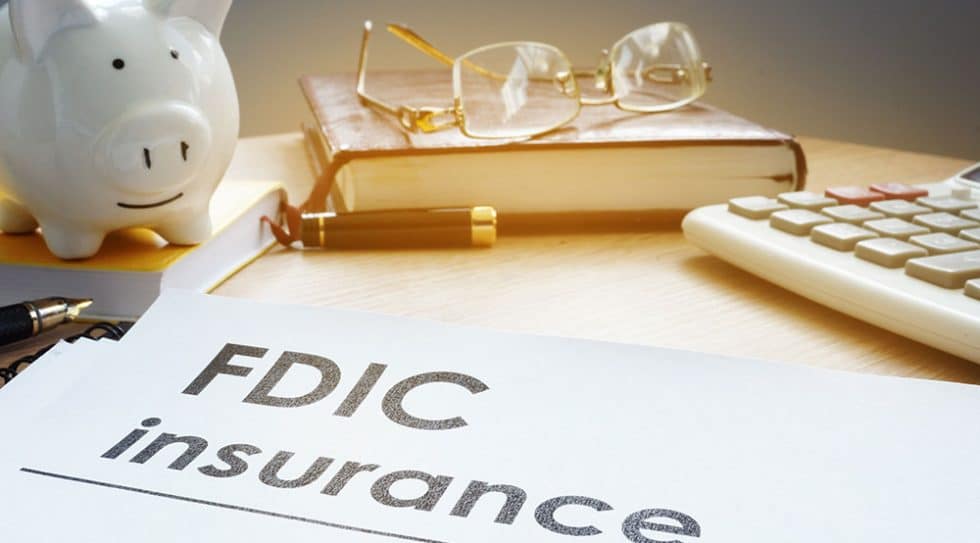This article explains the importance of diversifying within different CDs and FDIC covered institutions and a few of the horror stories that prove this importance.
History has a way of repeating itself.
Diversifying your certificates of deposit (CDs) across different banks can provide you with additional protection for your reserve funds, as well as potentially increasing your overall returns.
One of the main reasons to diversify CDs across different banks is to take advantage of FDIC insurance. The Federal Deposit Insurance Corporation (FDIC) is a US government agency that insures deposits in banks up to $250,000 per depositor, per insured bank. Be careful though, insurance coverage is predicated on your tax ID or EIN number, so if you have numerous accounts at the same institution over the $250,000 limit you stand to lose that additional money in the event of a bankruptcy. By spreading your CDs across multiple banks, you can ensure that your deposits are fully insured, even if you have a total of more than $250,000 in CDs.
Another reason to diversify CDs is to potentially increase your returns. While CDs generally offer higher interest rates than money market or savings accounts, the rates can vary widely between banks. By shopping around, or utilizing an HOA centric financial advisor to locate the best CD rates at different banks, you can potentially earn more interest.
Furthermore, diversifying CDs can also reduce the risk of losing all your savings in case of a bank failure. Even though the FDIC insures deposits up to $250,000, it may take some time to recover your money in case of a bank failure. By spreading your savings across multiple banks, you can reduce your risk of losing all your savings in one go.
Say Aloha to Your Reserves…
The Bank of Honolulu was a bank located in Hawaii that declared bankruptcy in 1986. At the time, it was the largest bank failure in Hawaii’s history and resulted in significant losses for many of the bank’s customers, including several property management companies that handled millions of dollars for Hawaiian HOAs.
One of the main reasons that customers lost money in the Bank of Honolulu bankruptcy was that they had deposits of more than $100,000 in the bank. At the time, the FDIC only insured deposits up to $100,000 per depositor, per insured bank. This meant that any deposits above that amount were not insured and were at risk in the event of a bank failure.
Many customers of the Bank of Honolulu had deposits well above the $100,000 limit, often due to their business accounts or personal savings and in the case of several HOAs that we are aware of, accumulated interest earnings from CDs at the $100,000 limit. When the bank failed, these customers lost a significant amount of money, as their excess deposits were not insured by the FDIC.
Furthermore, there were also allegations of fraud and mismanagement by the bank’s executives, which may have contributed to the bank’s failure. The bank’s executives were accused of making risky loans and engaging in other questionable business practices, which ultimately led to the bank’s collapse.
In the aftermath of the Bank of Honolulu bankruptcy, many customers were left with significant losses, and there were numerous lawsuits and legal battles related to the bank’s failure. The incident highlighted the importance of deposit insurance and the risks associated with having deposits above the insured limit in any bank.
Today’s Recent Debacle…
Silicon Valley Bank (SVB) was a bank that specialized in providing financial services to technology and life science companies, as well as venture capital and private equity firms. While SVB had generally been a successful and profitable bank, it has experienced losses in recent years due to a variety of factors.
One of the main factors contributing to SVB’s losses in recent years has been the impact of the COVID-19 pandemic on the economy and the technology industry. As many businesses have struggled during the pandemic, SVB has seen an increase in loan delinquencies and defaults, particularly in sectors like hospitality and retail that have been hit hard by the pandemic.
In addition, SVB has faced increased competition from other banks and financial institutions that are also looking to serve the technology and life science industries. This competition has put pressure on SVB’s margins and profitability, as the bank has had to offer more attractive terms and rates to win and retain business.
Another factor contributing to SVB’s losses has been the bank’s expansion into new markets and geographic locations. While this expansion had been a key part of SVB’s growth strategy, it has also brought new risks and challenges, particularly in markets where the bank may have less experience and expertise.
Despite these challenges, SVB remained a well-respected and important financial player in the technology and life science industries until this announcement. Unfortunately for many, It will take some time to sort out this most recent failure and you can bank on it, it will happen again.
Of course, no bank is immune to risks and challenges, and there are always potential factors that could impact the financial health of any bank.
Unfortunately by the time the public at large hears about these problems, it’s usually too late to make any changes.
Don’t Bank on It…
While the banking industry has generally been stable over the last 10 years following the Great Recession, according to the FDIC website there have been 72 Bank failures throughout the nation. Here are just a few examples of banks that have declared bankruptcy over the last 10 years:
Guaranty Bank – In 2017, Guaranty Bank, a regional bank based in Wisconsin, was shut down by federal regulators and its deposits were transferred to First-Citizens Bank & Trust Company. Guaranty Bank had been struggling with losses on its mortgages and other loans for several years prior to its failure.
First NBC Bank – First NBC Bank, a bank based in New Orleans that had focused on financing local real estate development, declared bankruptcy in 2017. The bank had faced numerous regulatory issues in the years leading up to its bankruptcy, including concerns about its loan and accounting practices.
The Bank of Union – The Bank of Union, a bank based in Oklahoma, declared bankruptcy in 2014. The bank had been struggling with bad loans and declining financial performance, and was unable to raise enough capital to stay afloat.
Bank of Whitman – Bank of Whitman, a small bank based in Washington state, declared bankruptcy in 2011. The bank had been struggling with bad loans and declining financial performance, and was ultimately unable to recover.
It’s worth noting that while these banks declared bankruptcy, their depositors were generally protected by FDIC insurance. Deposits up to $250,000 per depositor, per insured bank, are insured by the FDIC, so most customers of these banks should have been able to recover their deposits even in the event of a bank failure.
Time is Money… Really.
Another critical piece of information for you to be aware of becomes the time it takes to get your money from a defunct bank. This can vary dramatically depending on a number of factors, including the size of the bank, the complexity of its operations, and the amount of money involved. Here are some general guidelines to keep in mind:
FDIC insurance: If your bank is insured by the Federal Deposit Insurance Corporation (FDIC), you should be able to recover your deposits up to the insured limit of $250,000 per depositor, per insured bank. In most cases, the FDIC will work to pay out insured deposits as quickly as possible after a bank failure. According to the FDIC, most insured depositors are able to receive their insured funds within a few days of the bank’s failure. Our experience over the last 40 years, has been a little bit different in regards to brokered CD’s. In most situations, your Financial Advisor is able to liaison between the FDIC and their clients and can help to minimize the loss of insured monies in the process.
Uninsured deposits: If you had deposits in excess of the insured limit, you may need to wait longer to recover your money. In some cases, uninsured depositors may receive some or all of their funds back, but the process can take longer and may involve legal action. As I said earlier, time is money and if you are ever involved in this type of unsettling situation, I guarantee it will take a considerable amount of your valuable time.
Bank size and complexity: The larger and more complex the bank, the longer it may take to recover your funds. If the bank had a large number of accounts or complex financial arrangements, it may take longer for the FDIC or other authorities to sort out the bank’s assets and liabilities.
Legal action: In some cases, depositors may need to take legal action to recover their funds. This can be a lengthy and complicated process, costing your association or management company in legal fees and other ancillary expenses and may not result in a full recovery of funds.
In conclusion, working with a professional financial advisor who specializes in HOA Finance will help diversify your certificates of deposit across different FDIC-insured banks. This can help provide additional protection for your savings, potentially increase your returns, and reduce the risk of losing all your savings in case of a bank failure. While the banking industry has generally been stable in recent years, there have been some bank failures and bankruptcies, and it’s important to be aware of the risks associated with depositing funds in any bank. If you do have deposits in a defunct bank, the time it takes to recover your funds can vary depending on a number of factors, but working with the relevant authorities and staying informed can help speed up the process.
Remember to work with professionals, cover your assets, and never forget what Mark Twain said “history doesn’t repeat itself, but it often rhymes.”
Helping Helping You Build a Firm Financial Foundation For Your Future
Nico F. March is the Managing Director for The March Group, LLC. He has worked with Community Associations since 1974 and has served on several Boards, including the Board of Directors for the Community Association Institute (CAI), San Diego Chapter. His team has specialized in Corporate Cash and Association Financial Management since 1982 and has assisted over 1000 Associations, Nonprofits and Timeshares invest over $4 Billion in reserve, operating and reconstruction funds. Nico and his team work out of their San Diego and Wyoming offices and may be reached at 888.811.6501 or email [email protected] for further information and consultations.
The March Group is not a tax or legal advisor. We will be glad to work with your professional CPA and Attorney to help you with your financial goals. Neither the information contained herein nor any opinion expressed shall be construed to constitute an offer to sell or a solicitation to buy any securities mentioned herein. Securities offered through LPL Financial, Member FINRA/SIPC.
The opinions voiced in this material are for general information only and are not intended to provide specific advice or recommendations for any individual or organization.



